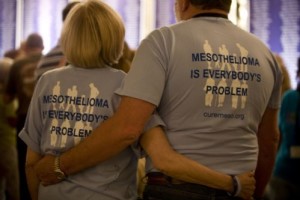It never gets any easier. Every year I make my way to the Mesothelioma Applied Research Foundation‘s annual symposium, and every year I’m reminded of why I do what I do.
Each year, for three days, the mesothelioma community gathers in Washington D.C. to exchange medical and scientific updates, network with other allies in the fight to cure meso, and visit The Hill to ask our congressmen and women to allocate funds for mesothelioma research.
Friday evening, they have a tribute ceremony with a huge display of names etched on to a tribute wall. Our firm has a lot of names on that wall. I, personally, have represented a lot of names on that wall. Too many.
 So why does this annual pilgrimage relate to being a trial attorney? Because we all play a part in this small but special community, and I know my role well. My job is to fight for the rights of individuals and families who have been wronged through no fault of their own. That’s my contribution. And nothing inspires me more to keep fighting on their behalf than to have a good, hard look at that wall.
So why does this annual pilgrimage relate to being a trial attorney? Because we all play a part in this small but special community, and I know my role well. My job is to fight for the rights of individuals and families who have been wronged through no fault of their own. That’s my contribution. And nothing inspires me more to keep fighting on their behalf than to have a good, hard look at that wall.
When you stand in a room with 300 people who have lost a loved one to mesothelioma, it puts things into perspective. Like how academia and the general public has labeled mesothelioma an “orphan” of cancers. When you consider us separately – the doctors, the victims, and the anti-stereotypical lawyers – maybe we are orphans, in a sense. Together, though, nothing could be further from the truth. We are united by this disease, and it feels very present and all too personal.
The hardest part about this tribute ceremony is that wall shouldn’t exist. Mesothelioma, which is caused by asbestos exposure, is a man made epidemic. Asbestos, ironically called the “miracle mineral” was heavily used from the 1930s through the 1970s in the manufacturing, shipping and construction industries. According to the most recent data released by the Centers for Disease Control and Prevention in 2004, approximately 2,700 Americans die annually from mesothelioma, and experts expect that number to continue increasing through 2025.
Companies who made asbestos knew the dangers, but ignored them. Instead they choose to barter their employees and their families’ lives for a bottom line. Because it takes between 10 and 50 years from the time of exposure to develop a meso diagnosis, the full ramifications of asbestos exposure remain hidden until it is too late. Meanwhile, the general public remains unaware that products being used in 2010 – like some automobile parts, certain construction materials and pipe insulation – still contain asbestos.
One fact is certain. The dangers of asbestos exposure were known as long ago as the 1930s, and we still don’t have a full ban, and we definitely don’t have enough support for research.
The Meso Foundation, which celebrates its 10-year anniversary this year, provides a gathering place for those who have been impacted by mesothelioma. Those who have been diagnosed, families who’ve lost loved ones, lawyers who won’t tolerate injustice, and doctors who are passionate about conquering what medical experts consider the most aggressive cancer of all cancers.
 MARF has helped raise awareness about these companies and the dangers of asbestos exposure. In addition, they’ve awarded 67 peer-reviewed grants for over $6.4 million. Those grants have resulted in 32 scientific publications credits, including the world’s most prestigious medical journal, The New England Journal of Medicine.
MARF has helped raise awareness about these companies and the dangers of asbestos exposure. In addition, they’ve awarded 67 peer-reviewed grants for over $6.4 million. Those grants have resulted in 32 scientific publications credits, including the world’s most prestigious medical journal, The New England Journal of Medicine.
No one has done more to keep peoples’ names off that wall than MARF, and we at Simmons Hanly Conroy are proud to be their top supporter. We congratulate them for all the hard work they’ve done over the years to support the meso community.




